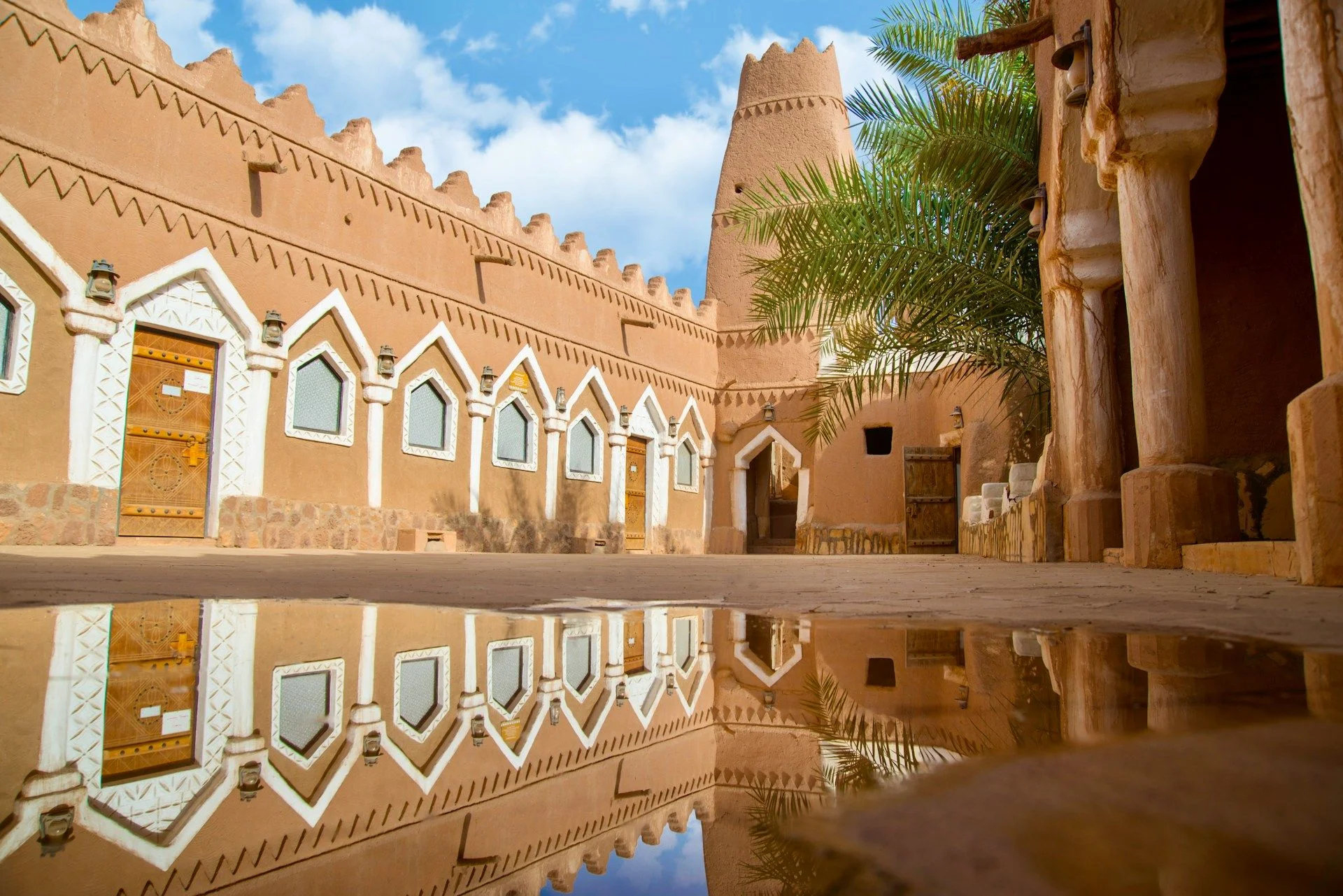Cultural and Adventure Trips in Saudi ArabiaAncient heritage sites, desert adventuresmodern cultural experiences

Advantages of traveling
to Saudi Arabia
Historic Wonders
Walk through Al-Ula’s archaeological marvels—Hegra’s rock-cut tombs, Dadan’s ancient city walls, and the UNESCO-listed UNESCO World Heritage site—immersing yourself in over 3,000 years of Arabian history.
Desert & Adventure
Experience the Empty Quarter’s sweeping dunes with 4×4 safaris, overnight Bedouin camp stays under star-filled skies, and guided sandboarding, all tailored to thrill-seekers and nature lovers.
Urban & Cultural Fusion
Discover Riyadh’s contemporary arts scene and Jeddah’s UNESCO-listed Old Town; savor world-class cuisine in luxury hotels and traditional souqs, blending modern comfort with authentic Arabian hospitality.
Historic Wonders
Walk through Al-Ula’s archaeological marvels—Hegra’s rock-cut tombs, Dadan’s ancient city walls, and the UNESCO-listed UNESCO World Heritage site—immersing yourself in over 3,000 years of Arabian history.
Desert & Adventure
Experience the Empty Quarter’s sweeping dunes with 4×4 safaris, overnight Bedouin camp stays under star-filled skies, and guided sandboarding, all tailored to thrill-seekers and nature lovers.
Urban & Cultural Fusion
Discover Riyadh’s contemporary arts scene and Jeddah’s UNESCO-listed Old Town; savor world-class cuisine in luxury hotels and traditional souqs, blending modern comfort with authentic Arabian hospitality.

Useful articles
and recommendations from experts
Tourism in Saudi Arabia: A Complete Guide
Saudi Arabia, spanning the majority of the Arabian Peninsula, offers an extraordinary blend of ancient civilizations, vast desert landscapes, and rapidly evolving urban centers. Tourism in Saudi Arabia has undergone a dramatic transformation with the launch of the Kingdom’s visionary Vision 2030 program, which opened historic sites to international visitors and invested in luxury resorts, cultural festivals, and archeological parks. Whether you’re tracing the Nabatean caravan routes at Al-Ula, scaling the towering cliffs of the Asir Mountains, or exploring the modern architecture of Riyadh’s King Abdullah Financial District, travel experiences in Saudi Arabia connect the past with the present. Comprehensive new visa policies, expanded air routes, and world-class hospitality infrastructure mean that how to visit Saudi Arabia has never been easier for leisure travelers, cultural enthusiasts, and adventure seekers alike.
Planning how to visit Saudi Arabia involves selecting from a range of best tours in Saudi Arabia that showcase the Kingdom’s diversity: guided archaeological expeditions, eco-safaris into the Empty Quarter, urban art and culinary walks, and Red Sea diving adventures. This guide provides practical insights on transportation networks—high-speed rail, domestic flights, and coastal ferries—alongside seasonal considerations and cultural etiquette. We’ll also highlight standout itineraries for newcomers and return visitors, ensuring you craft a seamless journey that maximizes immersion in Saudi Arabia’s hidden gems and marquee attractions.
Why Saudi Arabia is Attractive for Travelers
Saudi Arabia’s appeal stems from its unparalleled cultural heritage and the stark beauty of its natural environments. The Kingdom preserves some of the world’s oldest continuously inhabited sites—from the rock-cut tombs of the Nabatean city of Hegra (Madâ’in Sâlih), Saudi Arabia’s first UNESCO World Heritage site, to the mud-brick architecture of the Hijaz towns of Jeddah’s Al-Balad district. These ancient monuments coexist with cutting-edge museums like Riyadh’s National Museum, which presents 12,000 years of Arabian history through multimedia exhibits. For those seeking natural wonders, the Empty Quarter (Rubʿ al-Khali) covers more than 650,000 square kilometers of sand seas, offering dramatic dune-bashing in 4×4 convoys, Bedouin hospitality in remote desert camps, and camel treks at dawn. The Red Sea coast boasts pristine coral reefs and newly developed luxury resorts on islands such as Neom’s Sindalah, providing world-class snorkeling and diving. In major cities, modern skyscrapers share skylines with historic mosques: Riyadh’s Kingdom Tower and Jeddah’s King Fahd’s Fountain stand alongside centuries-old souqs and palaces. This multifaceted landscape ensures tourism in Saudi Arabia meets the interests of history aficionados, adventure tourists, and luxury travelers alike.
Main Types of Tourism in Saudi Arabia
Saudi Arabia accommodates a broad range of travel styles, each with specialized best tours in Saudi Arabia. Cultural & Heritage Tourism centers on the Hijaz region’s holy cities and ancient trading posts: pilgrims and history buffs can join guided tours of Madinah’s Prophet’s Mosque and Mecca’s Grand Mosque (for those invited), as well as explorations of Taif’s Ottoman-era palaces and the UNESCO-listed Egyptian-style ruins at Al-Ula. Desert Adventure Tourism offers immersive desert safaris into the Nafud and Dahna dunes, sandboarding lessons in the Empty Quarter, and starlit camp experiences with traditional Bedouin music. Urban Tourism focuses on contemporary Saudi life—food tours of Jeddah’s Corniche cafés, art-district walks in Diriyah’s UNESCO-protected At-Turaif, and rooftop lounges in Riyadh’s King Abdullah Financial District. Eco and Coastal Tourism features scuba diving in the Red Sea’s coral gardens, snorkeling with whale sharks near Yanbu, and coastal hikes along the Asir range. Event Tourism peaks with global-scale events such as the Riyadh Season festival, the Jeddah Season winter carnival, and the Red Sea Film Festival, drawing international crowds. By selecting tailored packages—ranging from half-day city tours to multi-day desert expeditions—travelers craft bespoke itineraries aligning with their interests and timeframes.
Unique Attractions and Experiences
Among the most unique attractions in Saudi Arabia is the dramatic UNESCO-inscribed site of Hegra, whose 111 monumental tombs carved into pink sandstone cliffs rival Jordan’s Petra but remain far less crowded. In the Asir Mountains, the historic village of Rijal Alma’ offers intricate stonework homes perched on terraces, while the nearby Asir National Park supports eco-lodges and zipline adventures. The nascent Red Sea coastal destination of NEOM features the futuristic The Line city concept and the Sun City resort on the OXAGON peninsula. Visitors can dive shipwrecks and vibrant coral reefs along the Al Lith coast, encounter flamingos in the Farasan Islands Marine Sanctuary, or feast on Hejazi street food—kunafa, mutabbaq, and camel burgers—in Jeddah’s Al-Balad district. Traditional experiences include attending a camel race at Taif’s Al-Harajah track, learning falconry in Najran’s royal preserve, and sampling authentic Arabian coffee and dates in a Bedouin majlis. These attractions in Saudi Arabia showcase the Kingdom’s rapid evolution while preserving its deep cultural roots.
Practical Tips for Travelers
When planning how to visit Saudi Arabia, note that the Kingdom issues tourism e-Visas to citizens of over 50 countries, valid for multiple entries over one year with stays up to 90 days. Domestic travel is facilitated by a network of low-cost airlines (Saudia, Flynas) and a planned high-speed rail line linking Riyadh, Jeddah, and the Dammam region. Car rentals are widely available, but foreign drivers must obtain a temporary Saudi license. Women may now drive freely, yet mixed-gender seating is still regulated in some public buses. Dress codes require modest attire: long sleeves and trousers for men, and an abaya for women, though headscarves are no longer mandatory for tourists. Credit cards are accepted in most hotels and larger shops; carry cash for small-town souqs and street vendors. Friday is the weekend in Saudi Arabia—plan sightseeing around mosque prayer times and note that many attractions close briefly for midday prayers. Tap water is treated but travelers often prefer bottled water. Climate varies: coastal summer highs can exceed 45 °C, while winter nights in the desert may drop below 5 °C; pack layers and stay hydrated. By following these Saudi Arabia travel tips, visitors ensure respectful, safe, and enjoyable journeys.
Seasonal Demand and Visitor Flows
Visitor numbers in Saudi Arabia peak during cooler months (October–April), when daytime temperatures range from 20–30 °C—ideal for desert excursions and outdoor festivals like Riyadh Season (October–March) and Jeddah Season (December–February). Hajj season draws millions of pilgrims to Mecca and Medinah, significantly increasing hotel rates and requiring early bookings for cultural tours. The summer months (June–August) see reduced leisure tourism in interior regions due to extreme heat, while coastal areas like the Red Sea and Eastern Province remain moderately busy thanks to sea breezes. Ramadan alters daily schedules—fasting hours vary by season—and many restaurants operate only after sunset; however, post-iftar cultural events and late-night souqs offer unique experiences. Aligning travel dates with non-pilgrimage windows and festival calendars allows visitors to access the best tours in Saudi Arabia at optimal prices and crowd levels.
How VelesClub Int. Enhances Your Travel
VelesClub Int. supports your exploration of Saudi Arabia through an integrated digital platform that simplifies trip planning and on-ground logistics. The service provides curated listings of luxury desert camps, boutique hotels in Al-Ula, and seaside resorts along the Red Sea coast, complete with verified guest reviews and secure online booking. Its travel concierge arranges private guided tours of Hegra, Bedouin-style desert safaris, and exclusive access to art installations at Diriyah’s Turaif district. Real-time assistance covers visa queries, transport coordination (from domestic flights to 4×4 transfers), and local event reservations for festivals and cultural performances. By uniting property services, legal guidance, and personalized itinerary management, VelesClub Int. ensures that every aspect of your tourism in Saudi Arabia—from initial planning to final departure—is seamless, enriching, and deeply authentic.
